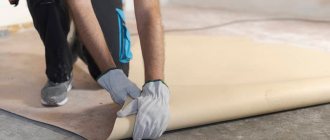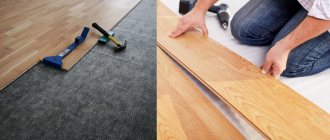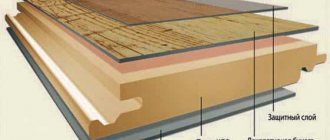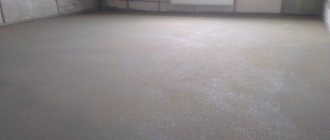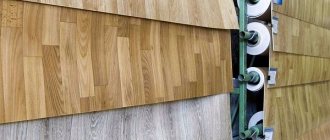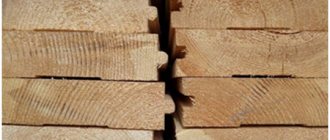08/11/2019 Laminate is a finishing coating that is easy to install and provides an ideal appearance for floors. Like other types of decking, the sub-base must be carefully prepared before installation. This stage directly determines how high quality and how long the coating will serve.
There are several technologies that are used by modern builders to make subfloors. Many of them, for example semi-dry screed, simply cannot be made with your own hands. We suggest that you familiarize yourself with the types and technologies for installing a subfloor under a laminate, which can be used without the involvement of specialists:
- Rough concrete screed for floor coverings;
- Preparation of floors with self-leveling mixtures;
- Dry prefabricated floor screed;
- Installation of wooden slabs on joists;
- Installing laminate flooring on a subfloor.
Rough concrete screed for floor coverings
The technology for preparing a rough surface using cement screed has been used in construction and renovation for decades. Although technology has stepped forward, and the market has been filled with more efficient materials and technologies, this type of rough foundation does not lose its relevance to this day. The reason lies in the significant advantages of such coatings, namely:
- high strength;
- wear resistance;
- durability.
Selection of materials for screed under laminate
Previously, to prepare a concrete solution, it was necessary to purchase and deliver sand and cement, use a concrete mixer and mix the components in the correct proportions. Now manufacturers offer ready-made dry mixtures for rough screed, which greatly simplifies the installation process. Many such compositions contain special fillers that improve the properties of the material: they increase the hardening rate, provide additional strength, resistance to moisture and chemically aggressive environments. Such mixtures include:
- Reinforced floor screed Eunice Horizon. This composition contains reinforcing fibers. They significantly increase the resistance of the screed to “pulling out” loads that can occur due to the expansion of concrete and heaving of the soil (for private houses). This property allows the coating to be installed on “warm floor” systems, as well as in freezing unheated rooms.
- Floor screed Eunice Horizon HYDRO. It is a composition, one of the components of which is a water repellent. Its presence allows you to install floors in kitchens and bathrooms, without fear of losing their properties during use. This screed is suitable not only for laminate, but also for any other floor coverings, including ceramic tiles and porcelain stoneware.
- Floor screed EK LEVEL 1.1. with a self-leveling effect. This is a mixture that has increased fluidity when mixing. Due to this, the effect of spreading on the surface is achieved with the formation of a high-quality horizontal floor. This material allows you to level floors with large differences in height. The self-leveling effect is achieved even when applying a solution up to 8 cm thick. If the installation technology is followed, this mixture allows you to lay the laminate immediately after the screed has completely hardened.
How to install a rough screed: technology
The technology for arranging a rough screed includes basic stages, at each of which a number of works are performed:
- surface preparation;
- laying insulating materials;
- placement of beacons;
- preparing the solution;
- filling.
At the preparation stage, the existing base must be completely cleared of debris and dust free. All defects that could subsequently lead to destruction of the layer must be eliminated. Weak and loose areas are strengthened, and potholes with cracks are filled with putty.
Next, using a laser level, the layer thickness is marked on the walls. For these purposes, you can also use the STAYER construction painting cord. It is also called beating thread or marking line. The cost is cheaper than a laser level, and it allows you to apply markings in just one movement.
The base must be primed to improve adhesion and equalize moisture absorption. On concrete floor slabs, you can use the Knauf Betonkontakt primer, which is intended specifically for pouring screeds. It is better to apply in two or three layers, waiting for the previous one to dry completely.
To prevent the formation of condensation and the negative effects of moisture between the base and the screed, it is necessary to install insulation. This is especially important to do in private homes, where there is a high probability of exposure to dampness from the ground. Coating or roll materials can be used as waterproofing:
- Coating waterproofing Eunice Hydroplast. It is a cement-based dry mixture that mixes quickly and is easy to apply. Its main feature is counteraction. Moisture flows in both forward and reverse directions. Due to this, it reliably isolates the screed from the base.
- Mastic without bitumen Knauf Flechendicht. Ready-to-apply latex-based water-dispersed composition. It is characterized by high adhesion to mineral substrates and provides high insulating ability (class W7). Easy to apply using hand tools (brush, roller). Dries quickly (3 hours one coat).
- Ruberoid RPP-300 without topping. Attached to floors using bitumen mastic. Provides absolute moisture resistance.
- Polyethylene film BPS technical. An inexpensive option for arranging insulation in an apartment.
When using rolled waterproofing materials, their installation is carried out with a mandatory overlap of 20-30 mm. The joints are sealed by heat welding (polymer films) or using adhesive mastic (bitumen waterproofing). A damper tape must be installed along the perimeter of the walls. It will compensate for the thermal expansion of concrete and prevent the formation of cracks in it.
At the next stage, beacons are laid out on the floor. They are cards made of metal mesh with a large cell pitch. In addition to the fact that such meshes act as a level, they additionally reinforce the screed and increase its resistance to cracking.
At the last stage, the solution is prepared. Be sure to follow the instructions on the proportions of dry mixture and water. This will help avoid problems with subsequent pouring and loss of screed strength. The prepared solution is poured portionwise onto the floor and leveled according to the beacon rule.
The cement screed must undergo a full hardening period for subsequent use. According to the standards, it is 28 days.
Self-leveling floors: preparing floors with self-leveling mixtures
In multi-storey apartments, where flat slabs are used as flooring, it may be irrational to install a full-fledged screed under the laminate. Indeed, in this case it is enough to simply achieve ideal flatness and horizontality. An acceptable option is to use a self-leveling floor.
Self-leveling floors are dry mixtures based on cement or gypsum. Due to modifying additives, the solution acquires increased fluidity and spreads evenly on the surface. This creates a perfectly even layer both horizontally and flatly.
Selection of self-leveling floor materials for laminate
As mentioned, self-leveling floors come in gypsum and cement. Many may have doubts about the effectiveness of using gypsum mixture as a floor. However, in practice, this type of rough coating behaves in operation no worse than cement. And this result is achieved due to the presence of polymer additives in the composition. They increase strength, resistance to moisture, cracks and other influences.
For the rough base under the laminate, you can use self-leveling gypsum-based floors of the following type:
- Self-leveling floor OSNOVIT SKORLINE FK 48 R. Quick-hardening gypsum-based composition. It is applied with a thickness of 3 mm and provides a fast rate of strength gain. Ideal for prefabricated floors, including laminate and parquet.
- Self-leveling floor Dauer ECOLINE. Spreads well over the surface. Has a longer solution life (90 min). Characterized by increased resistance to expansion, cracking and moisture. It can be applied in a layer of 5 to 100 mm.
For a rough base under the laminate, you can use cement-based self-leveling floors of the following type:
- Self-leveling floor EK LEVEL 3.0. finishing. Suitable for smooth surfaces without defects. It will also be an excellent choice for perfectly leveling the surface of a rough screed. Apply in an ultra-thin layer from 1 to 10 mm. Hardens quickly and provides high strength even at this thickness.
- Self-leveling floor EK LEVEL 2.0. quick-hardening, moisture-resistant – designed specifically for rooms with high levels of humidity. The composition includes water repellents and plasticizers. It can be used for flooring in kitchens, hallways, and bathrooms. Thickness of the applied layer: 2-100 mm.
- Self-leveling floor Eunice Horizon universal quick-hardening Monolith. Can be applied from 2 to 100 mm. Additionally, it is reinforced with fibers, due to which it is able to withstand increased loads.
- Self-leveling floor Yunis Horizon is a universal, quick-hardening composition for obtaining a high-strength floor covering. It is characterized by the presence of plasticizers, due to which it has increased resistance to cracking and loads. Can be used on underfloor heating systems. Can be applied in layers from 2 to 100 mm.
How to install a self-leveling floor: technology
The technology for installing a self-leveling floor is somewhat simpler than that of a conventional screed. It includes the stages of preparation, preparation of the mixture, and application of the solution.
At the preparatory stage, the surface of the rough screed or monolithic slab is dust-free, and defects are eliminated. Next you need to prime the surface. You can use the above-described compositions or a deep-penetrating acrylic primer, for example, Ceresit CT 17 deep-penetrating primer.
After the primer has dried, a solution is prepared. To do this, the dry powder is poured into a container with water in the required proportion. To increase the vitality and reduce the preparation time of the solution, it is recommended to mix the components with a construction mixer. Moreover, a mandatory condition: the preparation of the self-leveling floor must be carried out exclusively at low mixer speeds . Otherwise, numerous bubbles form in the solution structure. They can create many problems during the further use of the floor.
The finished solution can be poured onto the prepared base. To level it on the surface, it is extremely important to use a needle roller for self-leveling floors!!! The reason is still the same - removal of air bubbles from the structure of the self-leveling floor.
When pouring a self-leveling floor, you cannot stop and postpone the process “for later” . One room should be completely filled with the mixture to ensure the integrity of the entire coating. Otherwise, you will be in for an unpleasant surprise in the form of destruction of the floor at the junction of the layers.
Once fully cured, proceed with the installation of precast flooring, laminate, parquet or other finished flooring.
Types of underlays for laminate
The intermediate layer not only absorbs sound, but serves as an excellent material for leveling the surface under the laminate. Types of substrates:
- Sheet backing. Available in large sheets measuring 1x0.5 meters, made of polystyrene. Has a thickness of 5 mm. Capable of eliminating irregularities up to 3.5 mm. Absorbs water and sounds well. It does not emit harmful substances and can be used under parquet boards.
2. Cork. Eco-friendly material, has high rigidity and friction. Suitable only for very smooth substrates, not suitable for wooden subfloors. Sometimes made with the addition of rubber. Be sure to lay an additional vapor barrier and moisture insulation layer under the cork - it can absorb liquid.
Interesting article on the topic: Is laminate flooring painted and how?
3. Foamed polypropylene. It is not afraid of moisture, masks all irregularities well, and provides ventilation. This material will not protect you from strong noise; do not use it if you plan to place a constant static load on the floor covering - air bubbles may burst.
4. Expanded polystyrene. Suitable for heavy loads, does not allow moisture to pass through, and provides good thermal insulation. It should only be placed on a perfectly flat floor. Cons: burns well and releases harmful substances when burned. Read in detail about the dangers of laminate flooring here:
5. Coniferous. Available in the form of tiles, they are not flexible and elastic, but they ventilate the coating well. It fits quickly because it has the same shape.
6. Foil. They produce single-sided and double-sided foil substrates. After installation, they create a “thermos effect”, which is why they are in demand in places where the room needs to be well insulated.
7. Polyethylene. Sold in rolls and often used by developers when delivering apartment buildings. Budget-friendly, economical, easy to install, but loses its properties after a few years.
8. Combined. They are made from a combination of materials - polypropylene, expanded polystyrene. Suitable for installing heated floors.
Anton Makarov
Expert of our site. She has been selling and installing floor coverings for over 7 years. Can give really valuable advice.
Ask a Question
Note! Choose a substrate based on the evenness of the rough coating, its material, as well as the technical characteristics of the room. For high loads, use polystyrene foam, and for protection against moisture, use foamed polypropylene.
Dry prefabricated floor screed
Dry prefabricated screed is a multi-layer system, where bulk materials are used as the base layer, and durable sheets are used as the top layer. This type of rough coating is characterized by quick installation, does not include “wet” and “dirty” work, and if the installation technology is followed, it guarantees a good final result.
Selection of materials for the manufacture of dry screed
When installing a dry screed, the main choice of materials comes down to determining the best filler and top floor sheets. Therefore, we will consider the material on this division.
It is customary to use bulk dry materials as filler. The most commonly used are expanded clay or expanded clay sand. When choosing, the fractional nature of the backfill deserves special attention. The presence of large fractions in the composition of particles is undesirable. Under load, fragments can break, which will lead to compaction of the filler and shrinkage of the floor.
The best option for installing dry screed is considered to be specialized ready-made backfill. They are supplied in 50 liter bags. It contains expanded clay filler with a homogeneous fraction from 1 to 5 mm. A cheaper material that is in no way inferior in quality is expanded clay in bags. The product is porous and absorbs moisture well, but it can only be used in dry, heated rooms.
A special slab material is laid on top of the filling. Its variety includes the Knauf-Superfloor moisture-resistant floor element 1200x600x20 mm. This sheet is made on the basis of gypsum fiber. It has sufficient thickness and strength to withstand increased loads. Features of the material also include the presence of a tongue-and-groove lock and ideal geometry. Thanks to the lock, simple joining of sheets is achieved without the formation of gaps. And thanks to the precision of the shapes, the floors guarantee excellent horizontalness after installation.
How to install a dry screed: technology
Installation of dry screed is less demanding in terms of preparatory work. This is explained by the fact that unevenness and other defects will be hidden behind the backfill layer. However, it is recommended to eliminate gross defects on the base. The fact is that to isolate the filler from the rough surface, a plastic film is placed between them. If there are chips and sharp protrusions, there is a possibility of damage to this barrier. This will lead to loss of insulation quality.
After removing defective areas, the base is cleared of debris. Markings are applied along the perimeter of the walls using a level or a tapping cord. Next, it is necessary to install the edge strip to a height equal to the thickness of the backfill and the thickness of the slabs. The tape compensates for linear elongations, which will make the floor operate flawlessly.
It is recommended to fill a layer of expanded clay sand with a thickness of at least 40 mm. If the layer is thinner, it will not be able to efficiently distribute the load. If it is planned to install communications in expanded clay, then the layer in this place can be from 20 mm. All communications must be laid in a durable pipe. It is advisable to use a metal corrugation of the required diameter. The maximum limit for filler thickness is 100-120 mm.
Next, the expanded clay is slightly compacted and leveled. Leveling the expanded clay surface is easy using a long rule. If its length is not enough, then before backfilling it is recommended to install beacons, along which the surface can subsequently be leveled.
When the installation of the filler is completed, you can begin laying the sheets. They are fastened to each other using suitable self-tapping screws. After installing the last fragment, you can immediately lay the laminate or other finishing coating.
Installation of slabs on joists
One of the most common ways to quickly install a subfloor under a laminate is to install the slabs along the joists. This method allows you to raise the floor to any desired level. It provides good geometry, strength and durability. Such floors can be installed relatively quickly due to the dimensions of the sheets. There is no “dirty” or “wet” work during the arrangement.
Selection of flooring materials by joists
Both wood sheets and cement-based sheets (CSB) can be used as materials for installing floors on joists. The most common materials for making floors on joists are as follows:
- OSB board. Made from compressed and glued wood chips. Characterized by high strength and resistance to breakage. Due to the moisture-repellent resins in the composition, it provides excellent performance. Can be used for corridors and kitchens. For floor installation, it is recommended to use OSB-3 boards with a thickness of 15 to 22 mm, depending on operating conditions.
- Chipboard - chipboard. The chips are moistened with resins and pressed. Due to the resins in the composition, this material provides good performance properties when used in rooms with normal humidity. In terms of strength and resistance to breaks, it is slightly inferior to OSB boards. However, it can be used for installing floors on joists. The recommended thickness of chipboard boards is 16 mm or more.
- DSP plate. It is a material based on pressed cement and shavings. It has excellent geometry, high strength and load-bearing capacity. For floors on joists, it is recommended to use sheets with a thickness of at least 12 mm.
Timber is most often used as lag. This can be a beam with either a square or rectangular cross-section. The second option reduces the cost of the floor without compromising its technical characteristics. The most popular log sizes are 50x50, 50x100, 100x100. When using a beam with a rectangular cross-section, it must be placed with the narrow side on the base.
To ensure that the logs serve for a long time, do not change shape, and the floors do not begin to creak after a year of operation, we recommend paying attention to the following features:
- you need to choose quality timber, preferably grade 1, without large knots or other defects;
- the beam must have good geometry, large deflections are not allowed;
- check the degree of drying: humidity should not exceed 18-20%, otherwise, when drying out, the timber may bend, and the floors will become deformed and begin to creak;
- after delivering the material to the site, allow it to acclimatize for 1 day or more;
- Be sure to treat the timber with a protective compound, for example Senezh Bio or Senezh Ultra.
It is recommended to use a special type of self-tapping screws as fasteners - self-tapping screws. After screwing in, they lock into the material and prevent unscrewing from the wood on their own.
How to install a floor on joists: technology
Like other methods of arranging a subfloor, installation of slabs on joists begins with preparation. The surface of the base is cleared of debris and dusted. To strengthen the surface layer, it can be re-primed 1-2 times. This will subsequently prevent dust from getting through the gaps.
The level is struck on the walls with a construction cord or using a laser tool. A layer of waterproofing is laid on the rough base. It can be glassine or thin roofing felt. Further along the level, logs are set.
To improve the performance properties and level the lags, a backing made of unedged boards is mounted on the surface. If it is not possible to get it, then you can use a sheet of fiberboard. It is cut into small fragments and the level of the logs is raised, leveling horizontally.
The logs are placed at a distance of 40 to 60 cm, depending on the thickness of the slabs. The thicker the slab, the higher the permissible distance between the lags. There is always a gap of 3 to 5 mm between the timber and the wall. It is needed to compensate for the elongation of wood due to thermal expansion.
The cut sheets are laid on the joists and fixed to them with self-tapping screws. If this is the installation of chipboard or OSB, then a compensation gap of 2-3 mm must be left between the sheets. The same gap is left between the slab and the walls. After laying the last element, you can begin the finishing coating.
Self-leveling compounds
By analogy with a concrete base, a layer of self-leveling mixture can also be poured onto wooden floors, but in this case its thickness will not exceed 2 centimeters. You can pour several layers according to the following scheme: 1 – drying – 1 – drying – …. Naturally, their number will be limited by the maximum permissible mass that the ceiling can withstand.
Filling this mixture is done as follows:
- Again, we start by preparing the base: we remove any remnants of paint and varnish materials, eliminate cracks and holes. You can use a thick consistency of self-leveling mixture.
- The surface is primed with a composition with moisture-repellent properties.
- The zero level is determined.
- All gaps between the floor and walls are sealed with polystyrene foam.
- Waterproofing material with a 10-15 cm spacing is laid on the walls.
- The filling composition is mixed.
- The mixture is poured onto the floor, leveled with a spatula and air bubbles are removed using a roller with needles.
- The next layer can only be applied after the first has completely dried.
The methods for preparing wooden floors for subsequent laying of laminate do not end there. For example, you can use a mixture of sawdust and PVA glue for puttying. You can make it yourself or buy it at a hardware store, which is advisable considering the low cost of the main components.
Summary: installation of prefabricated flooring (laminate and parquet boards)
Installation of laminate parquet boards or other flooring is the final stage of arranging the floor in the house. The technology for carrying it out is the same for each of the described rough foundations. The bottom line is that a polyethylene backing is placed on the surface. There is a damper tape around the perimeter of the walls. Next, the fragments are assembled together.
If the technology was followed exactly during the installation of rough coatings, then in the end you will get an ideal surface. It will allow you to simply and quickly lay the laminate and ensure its high quality of operation: without deformations, squeaks and other defects.
Cement-sand screed
Using a cement-sand mortar, you can obtain a monolithic base for laying any floor coverings. This eliminates significant differences in the surface, but you should not exceed 10 centimeters in the thickness of the screed so that the main floors of the building can withstand (for more details: “How to lay laminate flooring on a screed”).
Creating such a screed is quite simple, but, as in any matter, it is necessary to make efforts and diligence so that the result meets all expectations and the floors last as long as possible.
The floor is prepared for laying laminate using cement-sand mortar as follows:
- The subfloor is cleaned, covered with waterproofing material and taped around the perimeter with damper tape.
- Next, you need to determine the height of the future screed, which is also called the zero level. To do this, when measuring the base, its highest point is determined and 3 centimeters are added to it (about
